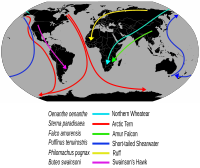
Photo from wikipedia
Organisms’ responses to past climatic extremes provide a useful perspective for understanding the impacts of ongoing and increasingly rapid climate change. Volant organisms can disperse long distances, allowing them to… Click to show full abstract
Organisms’ responses to past climatic extremes provide a useful perspective for understanding the impacts of ongoing and increasingly rapid climate change. Volant organisms can disperse long distances, allowing them to find and colonize new habitats during periods of change. However, the ability to move long distances does not necessarily imply increased responsiveness or resiliency to change. For example, long-distance migratory songbirds rely on innate genetic programs that may lack evolutionary flexibility, making it more challenging to track rapid environmental change (1). The responses of migratory birds to historical climatic extremes, such as those of the Last Glacial Period, provide important context for the current challenges facing the natural world. In PNAS, Thorup et al. (2) show that a bird species could have maintained migratory behavior through the last 120,000 y, and that a migratory lifestyle might have been key to adapting to climatic shifts without suffering population declines. During the Last Glacial Maximum (21,000 y before present), ice covered large extents of the present-day breeding ranges of bird species that breed in the Northern Hemisphere during the boreal summer, including that of the red-backed shrike (Lanius collurio). Red-backed shrikes are birds of open habitats with scattered woody vegetation and hunt insects and other small animals, often impaling their prey on twigs, thorns, or wire. Today, the birds breed across western Eurasia and leave the Northern Hemisphere in the boreal winter; Thorup et al. (2) tracked individuals from breeding grounds in Scandinavia to nonbreeding grounds in southern Africa. At the Last Glacial Maximum, areas that, today, host suitable habitat would have been inhospitable for shrikes, and the species would have been almost or entirely absent
Journal Title: Proceedings of the National Academy of Sciences of the United States of America
Year Published: 2022
Link to full text (if available)
Share on Social Media: Sign Up to like & get
recommendations!